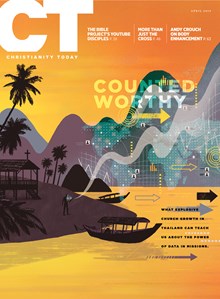 The April 2019 edition of Christianity Today features a cover story about DMM/CPM titled “Making Missions Count: How a Major Database Tracked Thailand’s Church-Planting Revival”: A movement in Southeast Asia shows how real-time reporting is building Great Commission connections.
The April 2019 edition of Christianity Today features a cover story about DMM/CPM titled “Making Missions Count: How a Major Database Tracked Thailand’s Church-Planting Revival”: A movement in Southeast Asia shows how real-time reporting is building Great Commission connections.
There are some interesting observations about the oft-debated use of metrics in ministry. It seems to me that the DMMs/CPMs I am aware of are constantly measuring and documenting the growth of the movement. Among other purposes, the use of metrics seems to serve as a kind of compass and a scoreboard that deeply motivates leaders and practitioners.
I am always interested in how Christian media writes about missiology. Commenting on the dynamics of the movement, article author Kate Shellnutt said this:
Out of 13 mother churches, FJCCA has added more than 400 house churches since 2016. Its biggest challenge has been training new leaders, who are tasked with continuing the work of evangelizing and church-planting. FJCCA focuses on a simple gospel presentation, prayer, and intimate fellowship, a model that converts can adopt and take to the next unreached village.
Rinnasak and fellow FJCCA leaders remove any “Christianese” from their phrasing, saying “Jesus bless you” rather than “God bless you” to specifically name the Christian God, and referring to believers’ “life experiences” rather than the more obtuse “testimony.” The association embraces the house church setting. When people convert in far-off villages with no Christian presence, it’s awkward and impractical for them to travel to existing congregations to learn and worship. Even once more mature churches move into buildings for Sunday worship, they still meet in homes as a more familiar location for discipleship.
Evangelists travel to villages with enough people ready to stick around to start the discipleship process. They share Bible stories and personal accounts to point to Jesus. Once people put faith in Christ, they invite them to pray right away for what they need, returning within a day or two to offer further training and materials from the Thailand Bible League, another partner.
Reach A Village noticed that the most effective church planters in the region share these distinctives. In Cambodia and Myanmar, the ministry also found that evangelism is “best carried out by local, indigenous believers and leaders who rely solely on the Scripture and the Holy Spirit with minimal outside interference or restrictions,” Craft said.
“Our ministry partner leader in Myanmar, Michael Koko Maung, once said to me, ‘Christianity came to us like a potted plant. We did not realize that when we took it out of the pot that it would grow so well in native soil.’ ”
FJCCA’s strategy is working, so much that Martin added a new staff member based in Phetchabun province dedicated to managing their figures. And he can barely keep up: Already, the movement has added 11,941 new believers in the past year and a half.
Read the whole thing.

1 comment:
Thanks for posting this. The more I learn about movements and the task remaining, the bigger fan I am becoming of keeping metrics. Just as Joshua project was revolutionary in defining the task remaining, this more detailed data is helping the global church organize and mobilize to the least reached places within somtimes huge and complex areas and groups of people. Also to be able to accurately report of what God is doing in the earth increases faith and increases focused and abudant prayer. Good Stuff!!
Post a Comment